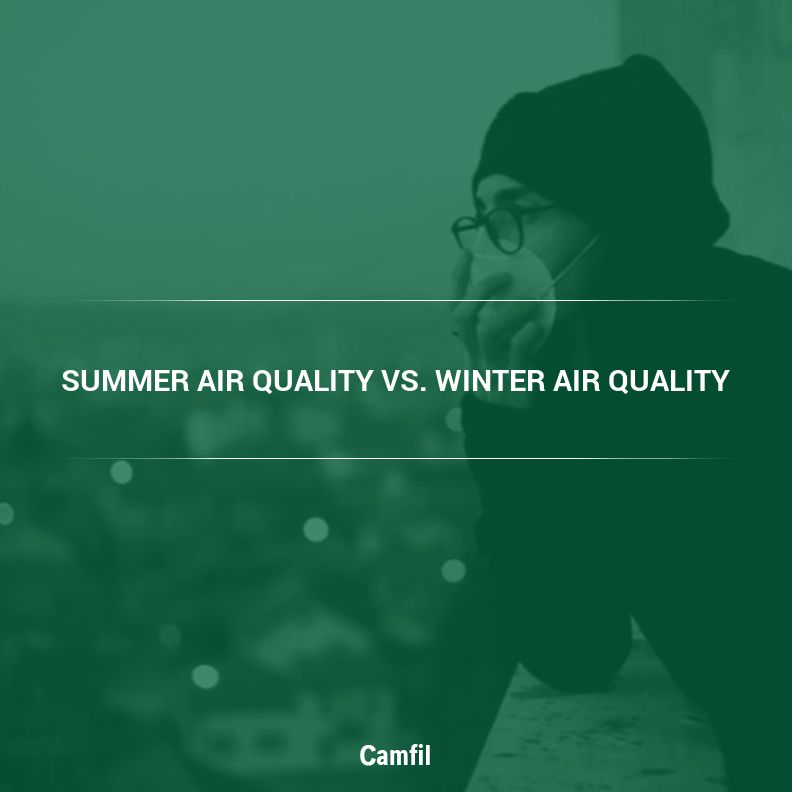Across the world, more people die from air pollution-related illnesses than in car accidents. During summer and winter months, weather patterns and other factors can cause increases in air pollutant concentration and worsened air quality. In this article, air quality experts from Camfil explain the factors that can lead to poor air quality in the summer and winter seasons.
Air Quality in the Summer
There are a variety of factors that can worsen summer air quality in certain regions, such as:
- Dry summer weather conditions. Extended periods of time with no rain allow dirt, soil, and sand to loosen, making it easier to be picked up and spread into the air by the wind. This leads to an increase in particulate matter levels in the summer in dry areas.
- Wildfires. The damage from wildfires varies year to year, but when high, smoke can travel thousands of miles. Wildfire smoke contains both particulate and gaseous pollutants that affect air quality thousands of miles away from the site of the fire.
- Summertime activities. Popular summer activities such as lighting bonfires, setting of fireworks, and traveling distances by plane and car release pollutants into the air.
- Summer thunderstorms. There is evidence suggesting that summer thunderstorms cause a unique distribution of plant spores and pollen that is known to cause asthma attacks and increased emergency department admissions.
Read more about air pollution levels in the summer.
Air Quality in the Winter
The winter season can bring about its own set of air quality issues. Contributing factors include:
- Inversions. Inversion layers create a near-surface temperature layer that doesn’t mix with the lower atmosphere, trapping pollutants in place and causing them to increase over time. This is especially true in areas with less wind, such as valleys and other low-lying areas.
- Indoor heating. The increased use of heating sources during the winter months also leads to higher concentrations of air pollutants. Home and commercial heaters can release particulate matter into the air which can cause asthma attacks and respiratory irritation. The burning of wood for heating can also release gaseous pollutants such as carbon monoxide, nitrogen dioxide, and sulfur dioxide into the air.
- Denser air. Cold air is denser than warm air, which means that it is moved less by wind. As a result, it is more difficult for the wind to disperse pollutants in the winter, leading to build-up and higher concentrations of pollutants in specific areas.
- Less precipitation. While some regions have dry summers, others have dry winters. Rain removes pollutants from the air as it falls, so when there is no rain for weeks or months at a time, concentrations of pollution continue to increase.
Summer Air Quality vs. Winter Air Quality
Ultimately, the severity of ambient air pollution levels in different seasons depends on an area’s climate and other regional factors. For example, the dry summer conditions of Nevada and Colorado are more prone to increased ambient pollution levels than the humidity and frequent rain storms in states like Virginia during the summer.
Use tools such as the World Air Quality Index to keep track of air quality in your area, or contact an air quality expert to learn more about ambient pollution patterns in your area.
Protecting Your Lungs with Premium Air Filtration
Reducing ambient air pollution levels is a long-term effort, but given that the average American spends more than 90% of their time indoors, and that indoor air can be as much as fifty times more polluted than outdoor air, combating poor indoor air quality with premium air filtration can help reduce health risks associated with air pollution. Room air purifiers and air filters for existing HVAC systems from Camfil use advanced technologies to capture both airborne particulate matter and gaseous contaminants to help provide relief from polluted outdoor air.
With offices and manufacturing facilities in 30 countries worldwide, six R&D labs and experience that spans more than 50 years, Camfil has the knowledge and expertise needed to develop custom solutions for any air quality challenge. Contact us today to learn more about how Camfil can help your family breathe cleaner air.
About Camfil Clean Air Solutions
For more than half a century, Camfil has been helping people breathe cleaner air. As a leading manufacturer of premium clean air solutions, we provide commercial and industrial systems for air filtration and air pollution control that improve worker and equipment productivity, minimize energy use, and benefit human health and the environment. We firmly believe that the best solutions for our customers are the best solutions for our planet, too. That’s why every step of the way – from design to delivery and across the product life cycle – we consider the impact of what we do on people and on the world around us. Through a fresh approach to problem-solving, innovative design, precise process control, and a strong customer focus we aim to conserve more, use less and find better ways – so we can all breathe easier.
The Camfil Group is headquartered in Stockholm, Sweden, and has 31 manufacturing sites, six R&D centers, local sales offices in 35+ countries, and about 5,200 employees and growing. We proudly serve and support customers in a wide variety of industries and in communities across the world. To discover how Camfil USA can help you to protect people, processes and the environment, visit us at www.camfil.us/
##
Media Contact:
Lynne Laake
Camfil USA Air Filters
T: 888.599.6620
E: Lynne.Laake@camfil.com
F: Friend Camfil USA on Facebook
T: Follow Camfil USA on Twitter
Y: Watch Camfil Videos on YouTube
L: Follow our LinkedIn Page
The post Is Air Pollution Worse in the Summer or Winter? Air Quality Experts from Camfil Weigh In appeared first on Air Filters for Clean Air.

